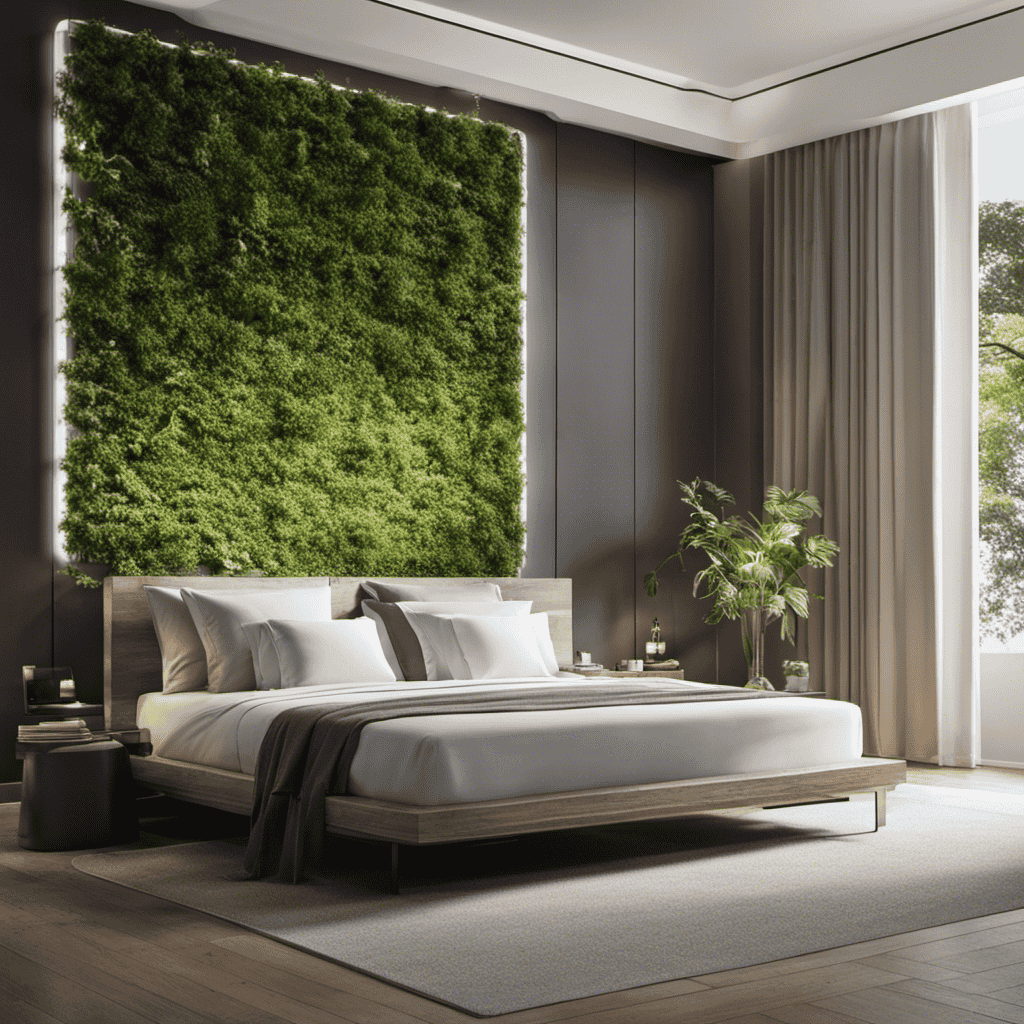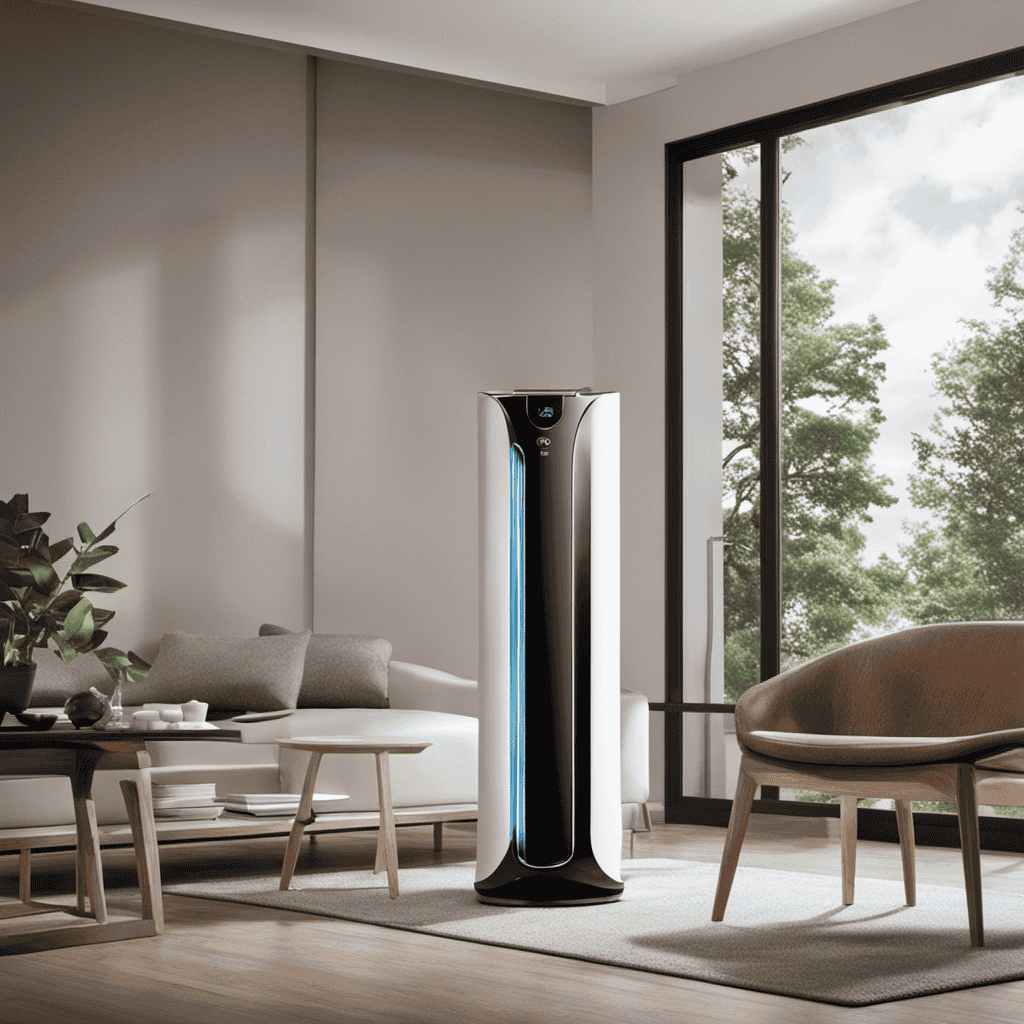Did you know that indoor air can be up to five times more polluted than outdoor air? That’s why it’s essential to find the right air purifier to ensure a healthy living space.
In this article, I will guide you through the key factors to consider when choosing an air purifier. We’ll explore different filter types, coverage area, noise level, energy efficiency, maintenance requirements, and additional features.
By the end, you’ll have all the information you need to make an informed decision and breathe easier.
Key Takeaways
- Consider different filter types available
- Evaluate suitability for allergies
- Ensure effective air circulation
- Understand the filter replacement frequency
Filter Types
When it comes to air purifiers, you’ll want to consider the different filter types available. There are several options to choose from, each with their own advantages and disadvantages.
One important factor to consider is the cost comparison between different filter types. Some filters may be more expensive upfront, but could be more cost-effective in the long run due to their longer lifespan.
Additionally, it is crucial to assess the environmental impact of the filters. Some filters may be made from materials that are harmful to the environment and may contribute to pollution when disposed of. It is important to choose filters that are made from eco-friendly materials and can be easily recycled.
Coverage Area
When it comes to choosing an air purifier, three key factors to consider are room size compatibility, effective air circulation, and suitability for allergies.
Room size compatibility is crucial because you want an air purifier that can effectively clean the air in the specific space you need it for.
Effective air circulation ensures that all areas of the room are reached and purified, while suitability for allergies means that the purifier can effectively remove allergens such as dust, pollen, and pet dander from the air.
Considering these factors will help you make an informed decision and choose the right air purifier for your needs.
Room Size Compatibility
The first thing to consider is if the air purifier is compatible with the size of your room. It is essential to choose an air purifier that can effectively purify the air in your specific room size. Here are some factors to consider when determining the compatibility of an air purifier with your room size:
-
Air quality sensors: Look for air purifiers that have built-in air quality sensors. These sensors can detect the level of pollutants in the air and adjust the purifier’s settings accordingly, ensuring optimal performance.
-
Cost-effective options: Consider the cost of the air purifier in relation to its coverage area. Some air purifiers may be more cost-effective for smaller rooms, while others may be better suited for larger spaces.
-
Room dimensions: Take into account the dimensions of your room. A larger room may require an air purifier with a higher Clean Air Delivery Rate (CADR) to effectively filter the air.
-
Noise level: Consider the noise level of the air purifier. For smaller rooms, a quieter purifier may be more suitable, while larger rooms can accommodate louder models.
-
Filter replacement: Check the cost and frequency of filter replacements. Cost-effective options will have filters that are affordable and need to be replaced less frequently, saving you money in the long run.
Considering these factors will help you find an air purifier that is compatible with the size of your room while also meeting your needs for air quality sensors and cost effectiveness. With the right air purifier, you can ensure that the air in your room is clean and healthy.
Transition: Once you have found an air purifier that is compatible with your room size, the next important aspect to consider is effective air circulation.
Effective Air Circulation
Once you’ve found an air purifier that’s compatible with your room size, it’s important to ensure effective air circulation. Proper air purifier placement is crucial for maximizing its performance and improving air quality.
To achieve optimal results, place the air purifier in a central location within the room. This allows for better distribution of clean air throughout the space. Avoid placing the purifier near walls or furniture that could obstruct airflow.
It’s also essential to keep the purifier away from sources of pollutants, such as smoking areas or chemical storage. By strategically positioning the air purifier, you can maximize its efficiency and ensure that it effectively removes airborne pollutants, allergens, and other contaminants, leading to a healthier and cleaner indoor environment.
Suitable for Allergies
To alleviate your allergies, make sure your air purifier is designed specifically for filtering out common allergens like dust, pet dander, and pollen. When selecting an air purifier for allergies, consider the following factors:
-
HEPA filtration: Look for an air purifier that uses High-Efficiency Particulate Air (HEPA) filters. These filters can capture tiny particles as small as 0.3 microns, effectively trapping pollen and pet dander.
-
CADR rating: Check the Clean Air Delivery Rate (CADR) of the air purifier. A higher CADR indicates a faster and more efficient filtration process.
-
Coverage area: Consider the size of the room where the air purifier will be used. Make sure the purifier is capable of cleaning the air in that specific area.
-
Noise level: Some air purifiers can be noisy, especially at higher fan speeds. Look for one that operates quietly to avoid disturbances.
-
Filter replacement: Check how often the filters need to be replaced and the cost of replacements. Regular filter changes are essential for optimal performance.
Noise Level
When researching air purifiers, it’s important to consider the noise level. Sound quality and decibel levels are crucial factors to assess the overall performance of an air purifier.
The sound quality refers to the characteristics of the noise produced by the device. A high-quality air purifier should emit a low-pitched, steady hum, indicating a well-designed motor and fan system.
On the other hand, decibel levels indicate the loudness of the purifier. Ideally, you should look for air purifiers with decibel levels below 50 dB, as anything above that can be disruptive in quiet environments.
Additionally, some air purifiers come with noise-reducing features, such as sleep mode or silent operation, which can further decrease the noise level and ensure a peaceful environment.
Energy Efficiency
If you want to save on electricity bills, you should consider an energy-efficient option for your air cleaning device. Energy efficiency is an important factor to consider when choosing an air purifier. Here are some key points to keep in mind when comparing air purifier brands in terms of energy efficiency:
-
Energy Star Certification: Look for air purifiers that have been certified by Energy Star. This certification ensures that the device meets strict energy efficiency guidelines.
-
Power Consumption: Compare the power consumption of different models. Look for air purifiers that have low power consumption while still providing effective air cleaning.
-
Energy-saving Features: Some air purifiers come with energy-saving features such as automatic shut-off or sleep mode, which can help reduce energy usage during periods of inactivity.
-
Filter Replacement Frequency: Consider the frequency of filter replacements. Air purifiers with longer-lasting filters can save you money in the long run.
-
Cost Comparison: Compare the upfront cost of different air purifier brands, as well as the estimated annual energy costs. This will give you a better idea of the overall cost of owning and operating the air purifier.
Maintenance Requirements
When it comes to maintaining an air purifier, there are several key points to consider.
First, understanding the filter replacement frequency is crucial in ensuring the effectiveness of the purifier.
Additionally, knowing the cleaning instructions and tips can help prolong the lifespan of the device.
Finally, exploring the warranty and service options is essential for any potential repairs or replacements.
Filter Replacement Frequency
The filter replacement frequency of an air purifier depends on how often you use it. In general, the more frequently you use your air purifier, the more often you will need to replace the filters.
There are several factors that can affect the frequency of filter replacements:
-
Longevity of filters: Some filters are designed to last longer than others. HEPA filters, for example, can typically last for 6 to 12 months before they need to be replaced.
-
Air quality: If you live in an area with high levels of pollution or allergens, your filters may need to be replaced more frequently.
-
Usage time: If you run your air purifier for longer periods of time each day, the filters will become clogged faster and will need to be replaced more often.
-
Maintenance: Regularly cleaning and maintaining your air purifier can help extend the lifespan of the filters.
-
Cost of filter replacements: It’s important to consider the cost of replacement filters when purchasing an air purifier. Some brands may have more expensive filters than others, so it’s worth doing some research to find the most cost-effective option.
Overall, it’s important to keep track of the recommended filter replacement frequency for your specific air purifier model and adjust accordingly based on your usage and air quality.
Cleaning Instructions and Tips
To keep your filters functioning properly, remember to regularly clean and maintain your air purifier according to the manufacturer’s instructions. Proper cleaning techniques and avoiding common mistakes are essential for maximizing the effectiveness of your air purifier.
When cleaning, start by unplugging the unit and removing the filters. Use a soft brush or vacuum attachment to gently remove dust and debris from the filters. Avoid using water or harsh chemicals, as they can damage the filters. Additionally, make sure to clean the outer casing of the purifier regularly to prevent the buildup of dirt and grime.
Common mistakes to avoid include using excessive force when cleaning the filters, as this can cause damage, and neglecting to clean the purifier regularly, which can decrease its efficiency.
Warranty and Service Options
Now that we have discussed cleaning instructions and tips for air purifiers, let’s move on to another important aspect to consider: warranty and service options.
When investing in an air purifier, it is crucial to understand the warranty coverage and service options available. Here are some key points to keep in mind:
- Warranty duration: Look for a warranty that offers a reasonable duration of coverage, ideally lasting several years.
- Coverage details: Read the warranty carefully to understand what is included and excluded from coverage.
- Service centers: Check if there are authorized service centers nearby to ensure convenient repairs or maintenance.
- Cost considerations: Consider the cost of extended warranties and evaluate if they provide good value for money.
- Customer reviews: Look for customer reviews regarding warranty claims and service experiences to gauge the manufacturer’s reliability.
Considering these factors will help you make an informed decision and ensure peace of mind regarding the warranty and service options for your air purifier.
Additional Features
One thing you should consider when choosing an air purifier is whether it has any additional features. Smart technology and customizable settings are two important features to look for.
Air purifiers with smart technology can connect to your smartphone or other devices, allowing you to monitor and control the air quality in your home remotely. This can be especially useful if you want to adjust the settings while you are away or if you want to receive alerts when the air quality drops.
Customizable settings, on the other hand, allow you to tailor the air purifier’s operation to your specific needs and preferences. You can adjust the fan speed, set timers, and even choose different modes depending on the level of air pollution.
These additional features can greatly enhance the effectiveness and convenience of your air purifier.
Frequently Asked Questions
How Do Air Purifiers Actually Work to Clean the Air in a Room?
Air purifiers work by using filters and other technologies to trap and remove pollutants from the air. They can be effective in removing pollutants and improving indoor air quality, but they have limitations and may not completely eliminate all odors.
Can an Air Purifier Remove Viruses and Bacteria From the Air?
An air purifier can effectively remove some viruses and bacteria from the air, but it has limitations. While it can trap larger particles, smaller ones may still pass through. Regular maintenance and proper filtration are essential for optimal performance.
Are There Any Potential Health Risks Associated With Using an Air Purifier?
When considering an air purifier, it’s important to be aware of potential health risks and negative effects. Understanding these factors can help me make an informed decision about what to look for in an air purifier.
Can an Air Purifier Help With Allergies and Asthma?
Yes, an air purifier can help with allergies and asthma. It effectively removes pet dander and other indoor pollutants, providing cleaner air and reducing symptoms for those with respiratory conditions.
How Often Should the Filters in an Air Purifier Be Replaced?
How frequently should air purifier filters be replaced, and what are the signs that indicate it’s time to replace them? Filters should be replaced every 3-6 months or when they appear dirty or clogged.
Conclusion
After analyzing the various elements to consider when selecting an air purifier, it is clear that filter types play a crucial role in improving indoor air quality.
Additionally, coverage area, noise level, energy efficiency, and maintenance requirements should not be overlooked.
Furthermore, it is worth exploring the plethora of additional features available in the market.
To make an informed decision, one must evaluate these factors meticulously.
Remember, a well-chosen air purifier can purify the air and promote a healthier environment for all.










